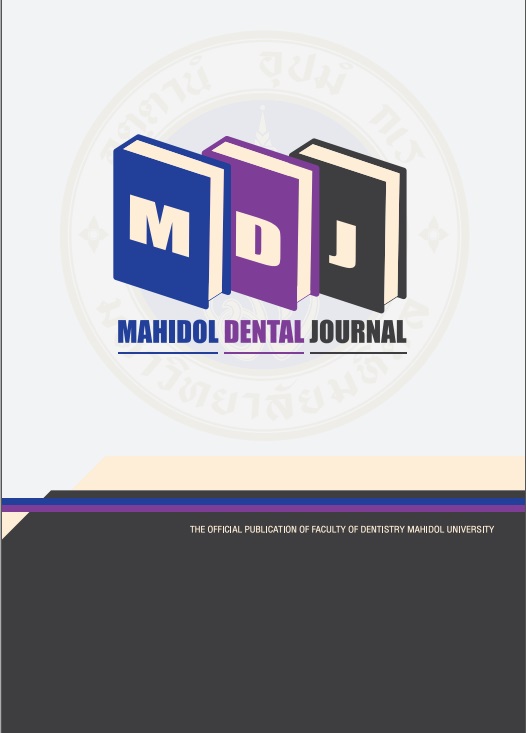Effect of different molecular weight of chitosan mouthwash formulations against Streptococcus mutans
Main Article Content
Abstract
Objectives: This study aimed to examine the antibacterial and antibiofilm properties of chitosan mouthwash formulations against Streptococcus mutans, using chitosan polymers of different molecular weight.
Materials and Methods: Chitosan mouthwashes at pH 6.0 were prepared from different molecular
weights of shrimp chitosan (30 kDa, 890 kDa) at various concentrations (2.5, 5.0 mg/mL). Chlorhexidine
mouthwash was used as a positive control. All formulations were evaluated for their antibacterial and
antibiofilm properties against Streptococcus mutans ATCC 25175. Antibacterial property was determined
by using the time-dependent killing effect at 0 minute, 30 minutes, and 2 hours. Reductive and preventive
properties on biofilm were assessed by adapting the microtiter plate test for quantification of biofilm
formation. Statistical analyses were performed using SPSS program version 17.0, with the significance
level at p<0.05.
Results: All chitosan mouthwashes, of different molecular weight and concentration, could reduce the planktonic form of Streptococcus mutans within 2 hours. Chitosan mouthwashes reduced established Streptococcus mutans biofilm by up to 92.27%, depending on the exposure time. The preventive effect of chitosan mouthwash against new Streptococcus mutans biofilm formation was improved to 97%.
Conclusion: Both low molecular weight and high molecular weight chitosan polymer could be used for mouthwash formulations with effective antibacterial and antibiofilm properties. Moreover, chitosan mouthwash had a greater antibiofilm property than chlorhexidine mouthwash.
Article Details
References
Featherstone JD. Caries prevention and reversal based on the caries balance. Pediatr Dent 2006; 28: 128-32.
Forssten SD, Björklund M, Ouwehand AC. Streptococcus mutans, caries and simulation models. Nutrients 2010; 2: 290-98.
Anderson MH, Bales DJ, Omnell K-A. Modem management of dental caries: the cutting edge is not the dental bur. J Am Dent Assoc 1993; 124: 36-44.
Wolff MS, Larson C. The cariogenic dental biofilm: good, bad or just something to control? Braz Oral Res 2009; 23: 31-8.
Flötra L, Gjermo P, Rölla G, Waerhaug J. Side effects of chlorhexidine mouth washes. Eur J Oral Sci 1971; 79: 119-25.
Emilson C, Lindquist B, Wennerholm K. Recolonization of human tooth surfaces by Streptococcus mutans after suppression by chlorhexidine treatment. J Dent Res 1987; 66: 1503-8.
Chung Y-C, Chen C-Y. Antibacterial characteristics and activity of acid-soluble chitosan. Bioresour Technol 2008; 99: 2806-14.
Chen C-Y, Chung Y-C. Antibacterial effect of water-soluble chitosan on representative dental pathogens Streptococcus mutans and Lactobacilli brevis. J Appl Oral Sci 2012; 20: 620-27.
Fujiwara M, Hayashi Y, Ohara N. Inhibitory effect of water-soluble chitosan on growth of Streptococcus mutans. New Microbiol 2004; 27: 83-6.
Pasquantonio G, Greco C, Prenna M, Ripa C, Vitali L, Petrelli D, et al. Antibacterial activity and anti-biofilm effect of chitosan against strains of Streptococcus mutans isolated in dental plaque. Int J Immunopathol Pharmacol 2008; 21: 993-97.
Kong M, Chen XG, Xing K, Park HJ. Antimicrobial properties of chitosan and mode of action: a state of the art review. Int J Food Microbiol 2010; 144: 51-63.
Younes I, Sellimi S, Rinaudo M, Jellouli K, Nasri M. Influence of acetylation degree and molecular weight of homogeneous chitosans on antibacterial and antifungal activities. Int J Food Microbiol 2014;185: 57-63.
Zheng L-Y, Zhu J-F. Study on antimicrobial activity of chitosan with different molecular weights. Carbohydr Polym 2003; 54: 527-30.
Sano H, Shibasaki KI, Matsukubo T, Takaesu Y. Effect of chitosan rinsing on reduction of dental plaque formation. Bull Tokyo Dent Coll 2003; 44: 9-16.
Stepanovic S, Vukovic D, Dakic I, Savic B, Svabic-Vlahovic M. A modified microtiter-plate test for quantification of staphylococcal biofilm formation. J Microbiol Methods 2000; 40: 175-79.
Naveed M, Phil L, Sohail M, Hasnat M, Baig MMFA, Ihsan AU, et al. Chitosan oligosaccharide (COS): An overview. Int J Biol Macromol 2019; 129: 827-43.
Abedian Z, Jenabian N, Moghadamnia AA, Zabihi E, Tashakorian H, Rajabnia M, et al. J Conserv Dent. 2019; 22:169-74.
Costa E, Silva S, Pina C, Tavaria F, Pintado M. Evaluation and insights into chitosan antimicrobial activity against anaerobic oral pathogens. Anaerobe 2012; 18: 305-9.
Yadav A, Bhise S. Chitosan: A potential biomaterial effective against typhoid. Curr Sci 2004; 87: 1176-78.
Costa E, Silva S, Costa M, Pereira M, Campos D, Odila J, et al. Chitosan mouthwash: Toxicity and in vivo validation. Carbohydr Polym 2014; 111: 385-92.
Thongaroon K, Phonghanyudh A, Surarit R, Kraivaphan P, Niamsiri N. In vitro antimicrobial activity of chitosan mouthwash against Streptococcus mutans and Lactobacillus casei. Walailak Procedia 2019; 2019(4):113.
Costa E, Silva S, Tavaria F, Pintado M. Study of the effects of chitosan upon Streptococcus mutans adherence and biofilm formation. Anaerobe 2013; 20: 27-31.
Costa E, Silva S, Madureira A, Cardelle-Cobas A, Tavaria F, Pintado M. A comprehensive study into the impact of a chitosan mouthwash upon oral microorganism's biofilm formation in vitro. Carbohydr Polym 2014; 101: 1081-86.
Decker EM, Von Ohle C, Weiger R, Wiech I, Brecx M. A synergistic chlorhexidine/chitosan combination for improved antiplaque strategies. J Periodontal Res 2005; 40: 373-77.
Farias JM, Stamford TCM, Resende AHM, Aguiar JS, Rufino RD, Luna JM, et al. Mouthwash containing a biosurfactant and chitosan: An eco-sustainable option for the control of cariogenic microorganisms. Int J Biol Macromol 2019; 129: 853-60.
Chung Y-C, Su Y-P, Chen C-C, Jia G, Wang H-l, Wu JG, et al. Relationship between antibacterial activity of chitosan and surface characteristics of cell wall. Acta Pharmacol Sin 2004; 25: 932-36.
International Standard Organization; ISO 10993-5(2009) Biological evaluation of medical devices—part 5: tests for in vitro cytotoxicity. [accessed 2019 Jan 24] Available from: http://www.dent.chula.ac.th/upload/images2/dent-bio-material/cytotoxicitytest/ISO10993_5_2009.pdf.


